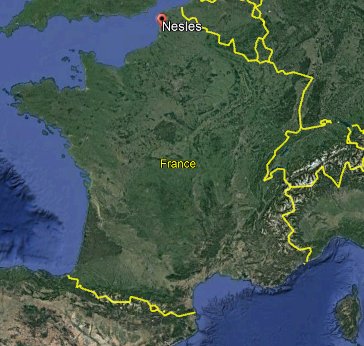
The index page for the 1954 French flap section of this website is here.
Reference for this case: 16-Oct-54-Nesles.
Please cite this reference in any correspondence with me regarding this case.
The "skeptical" ufologists Gérard Barthel and Jacques Brucker noted in their 1979 book:
"Nesle - 80 - 9:30 pm: investigation. Phenomenon similar to the observation of a star. Duration 1 hour!"
They specified that the observers confirmed to them: "it was a large star, very very high... a luminous point without shape, we saw it well during one hour, it went down slowly on the horizon."
The two authors indicate that they immediately thought of a planet but that the witnesses did not provide details to them on the angular height so they wene unable to check this.
[Ref. bbr1:] GERARD BARTHEL AND JACQUES BRUCKER:
The two authors note this case of October 16, 1954:
"Nesle - 80 - 09:30 p.m.: investigation. Phenomenon similar to the observation of a star. Duration 1 hour!"
They specify further that the observers confirmed to them: "it was a large star, very very high... a luminous point without shape, we saw it well during one hour, it went down slowly on the horizon."
The two authors indicate that they immediately thought of a planet but that the witnesses did not provide details to them on the angular height so they could not check this.

|
Barthel and Brucker presented themselves as less "stupid" than proponent ufologists, but often they wrote nonsense and uttered unverifiable claims.
The problems here are:
But there is more sillyness here:
They claim they were unable to identify the planet that caused this misinterpretation on the grounds that the witnesses did not give them the angular height. But:
Worse yet. It turns out that this October 16, 1954, at 09:30 p.m., a big meteor passed in the sky, generating numerous reports as shown in my catalog. I therefore wonder, since the witnesses apparently did not see the meteor in the Barthel and Brucker version, whether the observation was not that of this meteor, Barthel and Brucker then inventing all their "investigation", the duration, etc.
Now let's see about a planet or star near the horizon from this place and at that time.
We have the Moon, azimuth 51° 44', elevation 0° 58'. But it does not "go down", it goes "up."
We do not have Venus, beow the horizon sicne 06:34 p.m. until 11:15 a.m. the next day. Jupiter, Saturn, are not visible either.
Of course, we have some bright stars near the horizon, the brightest being Aldebaran, but none is very bright.
We have Mars, azimuth 211° 44', elevation 10° 9', in gentle "descent", it will be under the horizon at 11:11 p.m. at 230° with an ideally flat horizon. But it turns out that in this direction from Nesles, there are hills, which would explain very well that the observation would have lasted only one hour.
The "least worst" candidate planet would thus be Mars.
As this is the only planet that could fit, we can see that Barthel and Brucker's "regret" is quite vain.
(These keywords are only to help queries and are not implying anything.)
Nesles, Somme, duration, star, descent, slow, horizon
[----] indicates sources that are not yet available to me.
| Version: | Created/Changed by: | Date: | Change Description: |
|---|---|---|---|
| 0.1 | Patrick Gross | January 30, 2006 | First published. |
| 1.0 | Patrick Gross | December 28, 2009 | Conversion from HTML to XHTML Strict. First formal version. |
| 1.1 | Patrick Gross | December 11, 2019 | Addition of the Summary. Explanations changed, were "Not looked for yet." |